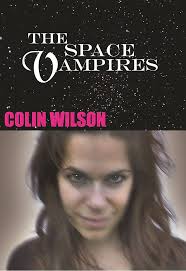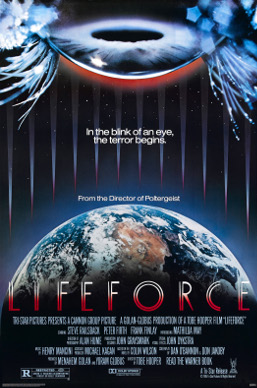Book 4 of my 26 books for 2024 goal! I’m a little behind, but in fairness, February is a short month. Why 26 books? I normally can read much, much faster than that pace, but the way life and work has been, I haven’t had as much time or energy to read as I would like. One book every two weeks seemed like a reasonable bare minimum goal.
This next book is one I’ve been interested in reading for a while! The Space Vampires, by Colin Wilson (1976).
The reason I’ve been interested in reading it is that it was the inspiration for the cult classic Tobe Hooper directed movie Lifeforce, that appeared in 1985, and freaked me out when I was younger!
The movie has one scene in particular where a desiccated corpse is being examined by a doctor, only for it to spring to life and drain the lifeforce of the doctor! That scene is still disturbing to me to this day, though the movie as a whole was less satisfying.
But what about the book? Well, the title tells you a lot, but let’s get into more details!
The Space Vampires is set sometime around the year 2100, when humans have started venturing out into the solar system. There is a permanent base on the moon, and ships regularly travel further to mine and collect asteroids.
But on one of these trips, something completely unexpected is found: a titanic alien spacecraft, seemingly derelict. Captain Carlsen is given approval from Earth to explore, and they find an interior filled with what seem to be some sort of stasis chambers. Most of these chambers are filled with strange squid-like alien forms, but several have what appear to be humans. Despite his misgivings, Carlsen is ordered to bring back three of these humanoids to Earth, and they manage to extract them from their cocoons, seemingly somewhere between life and death.
Carlsen and his crew are immediately famous for discovering the spacecraft that has become known as the Stranger, and Carlsen has enough pull to get an acquaintance into the laboratory where the alien bodies are being stored. Without warning, one of the females awakens and drains the very life energy from Carlsen’s guest. The aliens are vampires that feed on lifeforce, and soon they have escaped into the world and vanished seemingly without a trace. Carlsen, working together with Dr. Hans Fallada, a scientist researching energy vampirism, rushes to track down the deadly fugitives and stop whatever their plans are for Earth. But they could be anyone, as they can jump from human host to human host. And the duo are running out of time, as the Prime Minister of England wants to bring the Stranger into Earth’s orbit for further study, with its army of hibernating vampires…
The genesis of The Space Vampires is a curious story in and of itself. Colin Wilson was an incredibly prolific writer, not only writing fiction but also philosophy and books on mysticism and the paranormal. In the 1960s, he harshly criticized the work of H.P. Lovecraft in print, which enraged August Derleth, the champion and publisher of Lovecraft’s works. Derleth challenged Wilson to write something better than Lovecraft, and the result was The Mind Parasites (1967), which was published by Derleth’s very own Arkham House. Apparently Wilson got a bit of the Lovecraftian mythos bug after that, because he published another story in that vein only two years later, The Philosopher’s Stone, which I’ve blogged about in the past. The Space Vampires was a third foray into Lovecraftian ideas, which is made overt when it is revealed that the vampires refer to their race as the Ubbo-Sathla, which is a term borrowed from the work of Clark Ashton Smith but used in a very different way.
It seems that Wilson softened a bit towards Lovecraft’s writings, even speculating how much better he could have been if he had ever had a steady income. I don’t think he ever liked Lovecraft’s work, but he appreciated that it had some power to it. (This is fitting, because Lovecraft often had a similar view of many of his contemporaries’ work.)
Wilson used The Space Vampires and his other weird fiction to expound on his own philosophical musings, and the book is full of them. If you read it, be prepared for lengthy discussions of lifeforce and how it can be shared among people or stolen from people, usually through sexual activity. And there is a lot of sex and sexuality in the book — I lost track of how often some male character was lusting after an attractive woman in his vicinity. There is a significant detour in story when the investigators visit Ernst von Geijerstam, a man who wrote an early book about vampirism and is incredibly still alive thanks to his ability to harness a positive form of vampirism. During that visit there are even more discussions of energy transfer, sex, and how it all connects to human problems.
This may give the impression that the book is tedious, and at some points it did drag a bit, but overall I found it quite enjoyable and compelling. The final confrontation with the vampires is really compelling, and has a few surprise twists that I did not see coming and that made the book overall worthwhile. I should note that the ending is very, very different from the ending of the movie version, which involves a near-apocalyptic vampire plague ripping through London. The ending of the book is much more subtle, but very powerful in its own right.
So overall I had a good time reading The Space Vampires! It is weird, and has some very dated takes on male and female sexuality, but also provides lots of interesting ideas and a very compelling opening and closing acts.



